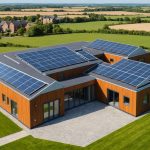Financial Advantages of Low-Energy Properties
Investing in low-energy properties can lead to significant financial returns. When compared to traditional properties, the reduction in energy costs offers a compelling argument for energy-efficient investments. These properties are designed to use less energy through innovative building techniques and advanced technologies, thereby lowering monthly utility bills. Over time, these savings can accumulate significantly, enhancing the financial appeal of such investments.
One of the critical aspects to consider is the impact of energy performance on property valuation. Properties with high energy efficiency ratings often experience enhanced property value. This is because buyers and investors are increasingly prioritising sustainability and cost savings. Consequently, energy-efficient properties can command a higher market price, providing property value enhancement for owners.
In parallel : Discover financial advantages: the benefits of residing in uk properties featuring communal spaces
Furthermore, there are also potential tax benefits and incentives associated with low-energy properties that can boost financial returns. Government initiatives often support energy efficiency by offering tax credits or subsidies, reducing the financial burden of initial investments in these properties. Collectively, these factors make investing in low-energy properties an economically sound decision for both immediate and future financial returns.
Methods for Upgrading Efficiency
Homeowners seeking to enhance their properties can achieve meaningful improvements through efficiency upgrades. Transitioning to more energy-conscious homes not only provides environmental benefits but also elevates property value. Two effective strategies focus on energy-saving renovations and adopting smarter investment strategies aimed at long-term financial benefits.
Also to discover : Your ultimate roadmap to buying property in the uk: key tips for expatriates coming home
Insulation and Weatherproofing
Effective insulation and weatherproofing serve as foundational elements of energy-saving renovations. By minimizing heat loss in the winter and keeping homes cooler in the summer, these methods significantly cut down energy consumption. Upgrading insulation can involve adding layers to walls, roofs, and floors or sealing windows and doors. This not only reduces expenses but also increases comfort and boosts property value.
Energy-Efficient Appliances
Equipping homes with energy-efficient appliances is another practical investment strategy. Appliances with high energy ratings, like refrigerators, washers, and HVAC systems, consume less power, leading to lower utility bills. They often come with rebates or other financial incentives, further making them a sound choice.
Renewable Energy Sources
Incorporating renewable energy sources such as solar panels is an ambitious but rewarding strategy. While the initial cost can be steep, the long-term savings and potential income from excess energy generation offer an appealing ROI. These investments align with growing sustainability trends, benefiting homeowners financially and environmentally over time.
Case Studies of Successful Investments
Exploring investment success stories in low-energy properties can provide valuable insights for property investors. One notable case involves a residential complex in London, which achieved remarkable ROI illustrations through energy-efficient measures. By integrating solar panels and high-performance insulation, the property significantly reduced energy consumption, leading to almost 40% savings on utility bills within the first year. This highlights how integrating sustainable technology enhances financial benefits.
Another compelling example is a commercial building in Manchester. Initially, the owners faced high energy costs due to outdated systems. By investing in comprehensive energy-saving renovations, including state-of-the-art HVAC and LED lighting systems, they transformed the building’s energy profile. Within three years, they experienced substantial returns, with energy costs dropping by 50%.
These low-energy property examples demonstrate the potential for substantial financial performance improvements. Lessons learned include the importance of thorough initial assessments and the strategic selection of energy-efficient technologies. Both cases underline the value of early adoption of energy-saving strategies for long-term financial returns.
Investors considering these areas should note that such successful projects benefitted from well-planned execution, which ensured maximum utilisation of available technologies and government incentives. This strengthens the case for low-energy investments as a lucrative financial strategy.
Potential Returns on Investment (ROI)
Exploring the potential returns on investment (ROI) for low-energy upgrades is pivotal for understanding their financial viability. On average, these upgrades offer a promising ROI, often exceeding traditional property investments. Factors such as energy savings, enhanced property value, and government incentives contribute to this favourable outcome.
Typical ROI for investing in energy efficiency upgrades ranges from 5% to 20%. This range depends on the scale of the improvements and the property’s location. Updating insulation, installing energy-efficient appliances, and integrating renewable energy sources like solar panels are pivotal actions that impact financial performance.
Several factors can affect the ROI of energy-efficient properties. These include initial investment costs, local energy tariffs, and government incentives. The integration of technologies such as smart systems or efficient HVAC units can also play a meaningful role. Comparing long-term gains and initial costs reveals that, while upfront expenses may be higher, the reduced energy bills and increased market value lead to substantial savings over time.
In addition, government incentives significantly enhance potential returns by reducing the financial burden of upgrades. Understanding these elements helps homeowners and investors make informed decisions, highlighting the practical benefits and strategic importance of adopting energy-efficient investments.
UK Government Incentives and Regulations
UK government initiatives provide robust support to encourage energy efficiency upgrades, significantly influencing property investment strategies. Homeowners and investors can benefit from various energy efficiency grants aimed at reducing the financial burden of implementing low-energy solutions. These incentives often come in the form of tax credits, subsidies, and financial assistance programs specifically designed to promote eco-friendly upgrades.
Policies such as the Energy Company Obligation (ECO) require energy providers to fund efficiency improvements, primarily targeting low-income households to improve overall property energy performance. Other schemes include the Green Homes Grant, although its availability has varied over time, providing vouchers for eco-upgrades.
Regulations have also shifted, focusing more stringently on building energy standards. Enhanced requirements for Energy Performance Certificates (EPCs) mean that properties must now meet higher efficiency thresholds. This regulatory pressure urges property owners to invest in better-performing technologies and materials.
These government efforts have significant implications for market dynamics. By prioritising energy efficiency, the UK sets a compelling case for investors to adopt eco-friendly strategies. This support structure not only facilitates financial gains but also aligns investments with emerging sustainability trends, promoting overall property value enhancement.





